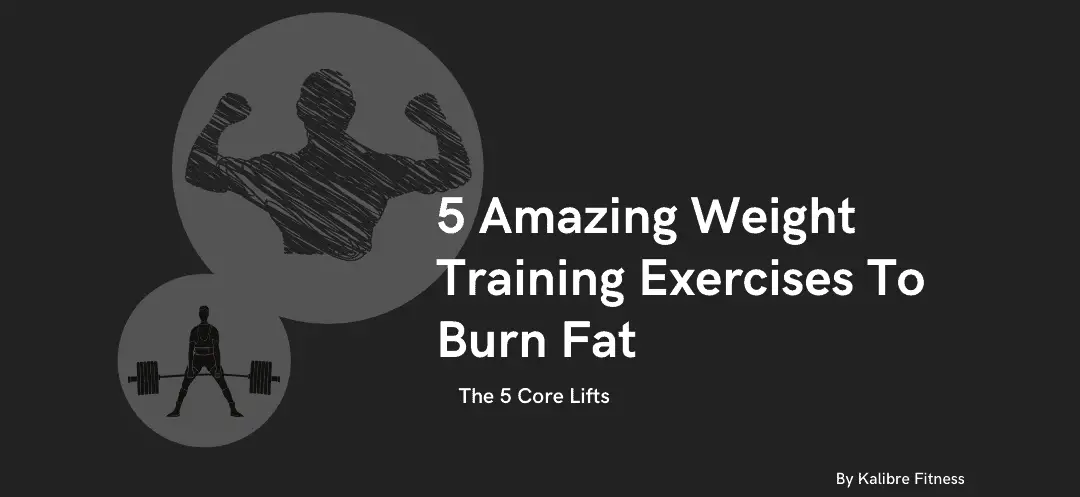Are you looking to start lifting weights to burn fat? yes? Then you are in the right place! In today’s post, we will detail how to perform compound weight lifting to burn fat.
For the last 2 years, I have been bodybuilding as a hobby. More specifically, I have been concentrating my workout program solely on big compound lifts. This type of exercise has resulted in impressive fat loss AND muscle gains. I now have my dream physique. Now I want to teach YOU too!
Read on to learn about compound lifting, the 5 core lifts, and how to perform them for maximal fat blasting!
Ready?
LEGGO!
Why Burn Calories With Compound Weight Lifting?
Before we begin, let’s define some terminology. What is compound weight lifting?
A compound exercise describes any movement which requires multiple muscle groups and joints to complete.
Therefore a compound weight lift describes a weight-training exercise that activates multiple muscles, around multiple joints. The classic example is a bench press.
Example Of A Compound Exercise

The bench press is a big movement. To complete a bench press, multiple muscles are activated and multiple joints are involved.(1)(2)
As we will see below, compound exercises are extremely efficient at torching calories.
How Does Compound Lifting Burn Calories?
Why are compound lifts so effective at burning calories?
Let’s briefly recap the answer from our previous weightlifting to burn fat guide.
Every time a muscle in the body contracts, it consumes energy. And energy is supplied by calories. Therefore, the more muscles activated, the more calories expended.(3)
This is a fundamental biological principle.
When you lift weights, energy expenditure occurs in 3 distinct ways.
3 Ways Weight Lifting Expends Energy
1)Energy Expenditure During A Workout.
2) Post-Exercise “Afterburn”.
3) Muscle Hypertrophy
1) Energy Expenditure During Compound Lifting
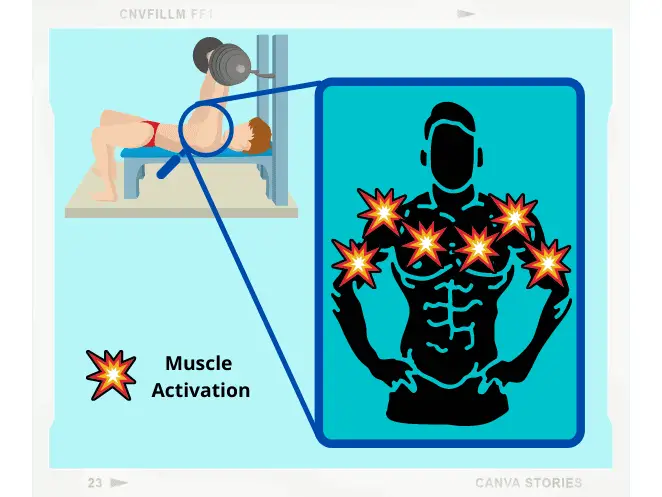
Have you ever wondered what happens to a muscle when you lift a weight?
Every individual muscle in the body contains its own “nutrient reserve”. This is an evolutionary mechanism that allows large amounts of energy to be quickly accessed for explosive movements (such as lifting a weight or when Mr Caveman had to run away from a Sabretooth tiger).
As the muscles contract, it depletes energy from the nutrient reserve.(4)
So why is compound weightlifting so effective at burning calories?
Since compound exercises activate a large number of muscle groups to complete a movement, they also deplete large amounts of energy with each movement.
This makes compound weight lifting great for burning calories during exercise!
2) Post-Exercise “Afterburn“
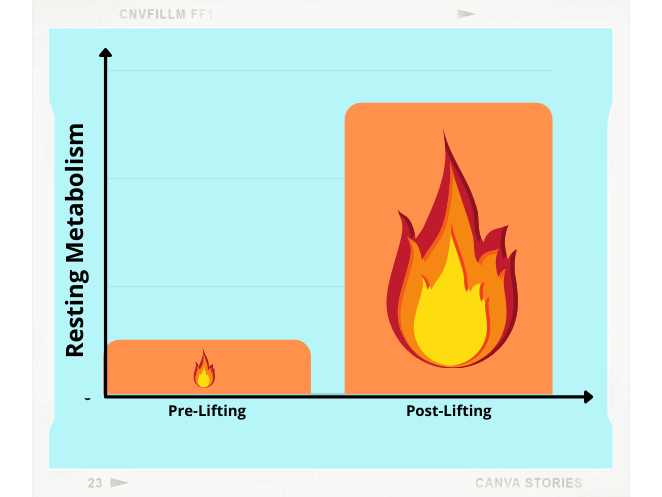
Energy expenditure doesn’t stop after weight training either.
That’s right- your muscles will continue expending calories, even after a workout!
This occurs through a process known as Excess Post-Exercise Oxygen Consumption (EPOC)(5), more commonly known as “Afterburn”.
Afterburn happens as the body attempts to refuel a muscle’s depleted nutrient reserve. This leads to steady calorie expenditure even after a workout finishes.
In fact, studies have shown afterburn to continue up to 48 hours after a workout!(6)
Since compound weight lifting activates many different muscles, the afterburn effect is induced in many muscles. This means increased calorie burning!
With compound lifting, you will literally torch calories in your sleep!
3) Muscle Hypertrophy
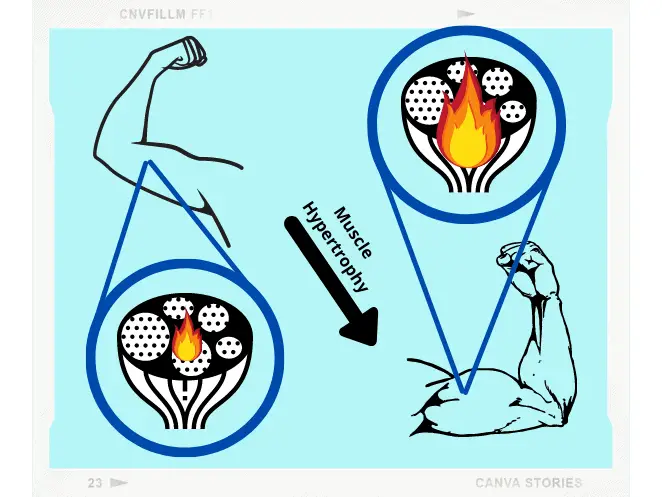
Have you ever noticed that people with a lot of muscle mass can often eat a lot, yet still look thin?!
Well, that’s because muscle is known as “metabolically active” tissue(7). This means it burns calories 24/7, even when you are watching TV.
The bigger your muscles, the more calories you will burn doing absolutely nothing!
Compound weight-lifting exercises are highly effective at increasing muscle size (muscle hypertrophy)(8).
And don’t worry- lifting weights alone will NOT lead to a bulky physique. This is a common misconception for new lifters.
Although weight lifting will stimulate muscle hypertrophy, building significant muscle mass requires a combination of heavy lifting and a large caloric surplus diet.
In the following section, we will provide video tutorials for 5 popular compound exercises. The videos may be oriented toward muscle building, but the same exercises will also lead to weight loss if you maintain a caloric-deficit diet.
The 5 Core Lifts
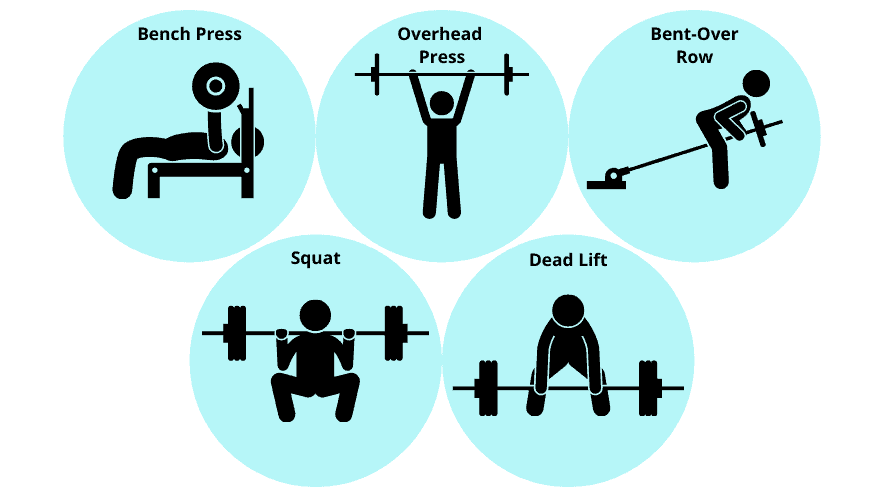
In the world of weight training, there are 5 specific exercises that appear in every program. They are the 5 core lifts.
The 5 Core Lifts
Bench Press | Overhead Press | Bent-Over Row
Squat | Dead Lift
The 5 core lifts are all compound exercises.
Each exercise hits multiple muscle groups. Combined together, they will work the entire body.
No matter if your goal is to lose fat or gain muscle, these 5 exercises are a MUST to incorporate into your training program.
Not only do the core lifts require tremendous amounts of energy to perform (therefore more calories burnt), but they also induce the afterburn effect throughout the entire body post-workout.
If you want the biggest “bang for your buck” for weight loss, performing the 5 core lifts will help you achieve your goals.(9)
Convinced?
Let’s see what each exercise involves!
The Bench Press
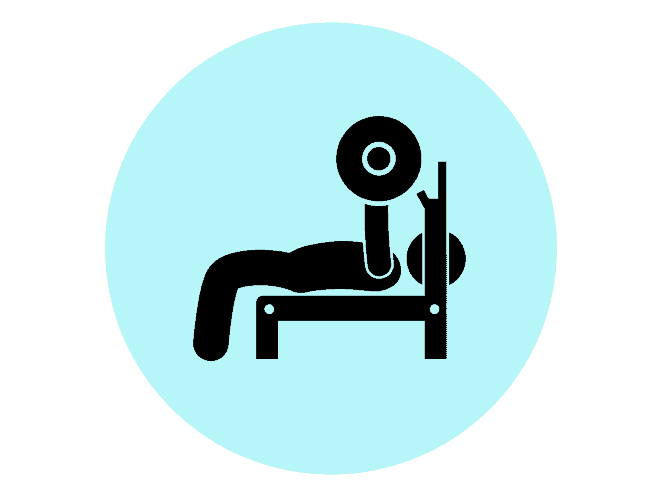
Probably one of the most famous exercises to exist. Every gym will have a bench press station.
The bench press is a simple up-and-down pushing, with arm movement through a plane perpendicular to the torso.
It primarily activates the chest and arm muscles, but core and back activation also occur to stabilize the body. This makes it a great upper-body exercise.
Muscles activated: pectoralis major (chest), pectoralis minor (chest), anterior deltoids (shoulders), posterior deltoids (shoulders), triceps brachii (arms), back/core (secondary activation). (10)
How to perform:
- Lie flat on a bench, eye level with the barbell. Keep both feet firmly planted on the ground.
- Grip the barbell with an overhand grip, just a bit over shoulder-width apart.
- Arch the back slightly, tighten the core, and squeeze your shoulder blades together. This will prime the body, ready to engage in the bench press.
- Inhale deeply and lift the barbell off the rack.
- Slowly lower the barbell to the middle of your chest (onto the nipple line). The barbell should just about touch the chest, with the elbows at a 45° angle.
- Drive the barbell upwards as you exhale. Stop the upward movement just before the elbows lock.
- Keep your back and core muscles engaged to provide stability.
- Repeat for reps.
The Overhead Press
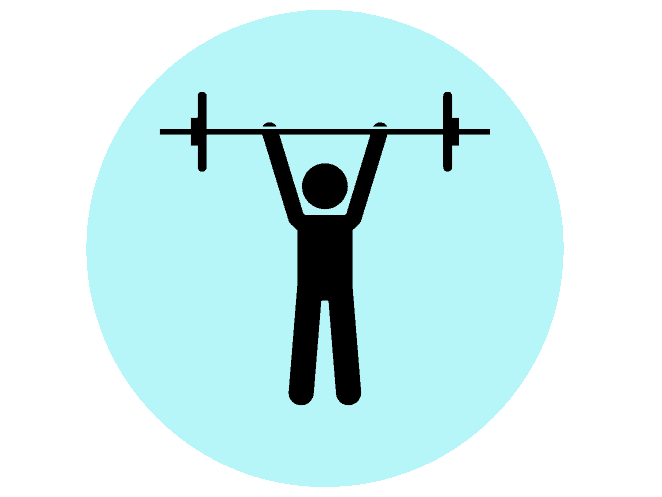
The cousin of the traditional Military press. Named so because the military used it as a test for upper body strength.
The overhead press is similar to the bench press. It also consists of up-and-down pushing. However, the plane of movement occurs parallel to the torso.
It primarily activates the shoulders, arms, and upper chest. But the core, back, and leg activation also occur to stabilize the body.
Muscles activated: anterior deltoids (shoulders), posterior deltoids (shoulders), rotator cuffs (shoulders), triceps brachii (arms), back/core/legs (secondary activation).(11)
How to perform:
- Prepare a barbell on a rack at chin level. Approach the barbell with a stable shoulder-width stance.
- Grip the barbell with an overhand grip, shoulder-width apart.
- Stick your chest out, arch the back slightly, and tighten the back and glutes. This will prime the body, ready to engage in the overhead press.
- Inhale deeply and lift the barbell off the rack. Make sure the head is slightly tilted back to avoid the bar hitting your chin.
- Drive the barbell vertically upwards as you exhale. Tilt your head forward as the barbell passes the head. This will help stabilize the movement and ensure the shoulders are engaged.
- Stop the movement just before the elbows lock.
- Keep your back, core, and glutes engaged to provide stability.
- Repeat for reps.
The Bent-Over Row

Probably the lesser-known of the 5 core family. Nevertheless, the bent-over row is a powerful exercise to expend big calories.
It is the opposite movement of the bench press. The yin to the bench press’s yang.
The bent-over row is a pulling exercise, with the plane of movement perpendicular to the torso.
It primarily activates the entire back, shoulder, and arm muscles. Core and leg activation also occurs to stabilize the body.
The bent-over row should always be paired with the bench press. Since they are polar opposites, performing both exercises will ensure balanced muscle development.
Muscles activated: trapezius (back), rhomboids (back), latissimus dorsi (back), obliques, rotator cuffs (back), posterior deltoids (shoulders), biceps brachii (arms), biceps femoris (arms), core/legs (secondary activation) (12)
How to perform:
- Prepare a barbell on the floor. Approach the barbell with a regular standing gait (i.e. slightly narrower than shoulder-width).
- Bend the legs, and grip the barbell with an overhand grip, shoulder-width apart.
- Lift the barbell off the ground, to knee level. Face your head forwards whilst keeping the back straight and at 45° to the ground.
- Inhale deeply.
- Pull the barbell towards the torso as you exhale. The barbell should touch the abdominals.
- Keep the legs bent and the head facing forward to stabilize the movement.
- Return the barbell to knee level in a controlled movement.
- Repeat for reps.
The Squat

Time to move onto the lower body now. That’s right- the legs!
Do not underestimate the power of the squat in burning fat. The largest muscles in the body reside in the upper legs (gluteus maximus, hamstrings, and quadriceps).
Therefore, exercises that activate these muscles will expend huge amounts of energy and burn lots of calories.
The squat is a lower-body pushing exercise, with the plane of movement perpendicular to the torso.
It primarily activates all the muscles in the entire leg. But the core and back are also engaged for stability.
This makes the squat an essential fat burner!
Muscles activated: quadriceps (upper leg), hamstrings (upper leg), gluteus maximus (upper leg), adductor (upper leg), sartorius (upper leg), gastrocnemius (lower leg), core/back (secondary activation) (13)
How to perform:
- Prepare a barbell on a rack. Approach the barbell with a shoulder-width stance.
- Lower the head beneath the bar, and rest the middle of the bar across the upper back and back of the shoulders.
- Inhale deeply as you lift the barbell off the rack.
- Slowly take a few steps back to clear some space from the rack.
- Take another deep inhalation, whilst bringing your hips back and bending the knees.
- Lower the barbell by bending the knees and bringing the torso towards the ground. As you do this, keep your head up and keep the back straight and at a 45° angle to the ground. This will ensure stable engagement of the back.
- Stop the movement when your hips are level with the knees.
- Drive upwards whilst exhaling.
- Repeat for reps.
The DeadLift
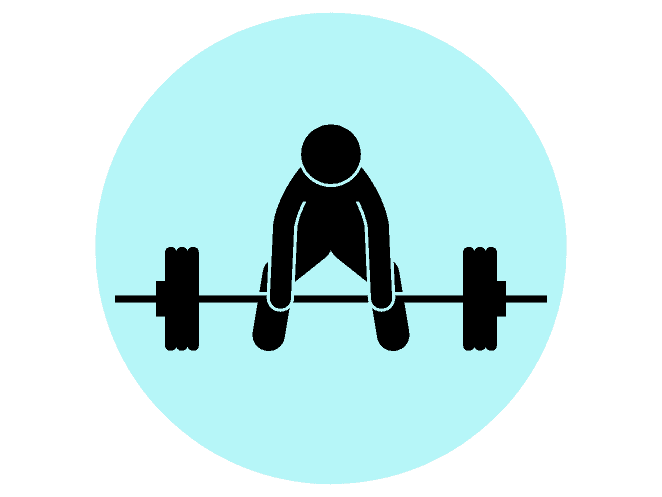
Last but certainly not least! The deadlift!
Regardless if you are trying to build muscle or lose fat, the deadlift NEEDS to be incorporated into your weight training program.
Strongman competitors are judged by it. Bodybuilders love it. Personal trainers recommend it. The deadlift really is the king of exercises.
Here’s why.
Remember when we explained how muscle activation requires energy expenditure? And the more muscles activated, the more calories are burnt.
Well, the deadlift is a behemoth of an exercise. It will activate ALL the muscles in the body. That’s a lot of calories burnt!
Muscles activated: quadriceps (upper leg), hamstrings (upper leg), gluteus maximus (upper leg), adductor (upper leg), sartorius (upper leg), gastrocnemius (lower leg), trapezius (back), rhomboids (back), latissimus dorsi (back), obliques, rotator cuffs (back), posterior deltoids (shoulders), anterior deltoids (shoulders), pectoralis major (chest), pectoralis minor (chest), core.(14)
How to perform:
- Prepare a barbell on the floor. Approach the barbell with a shoulder-width stance.
- Position both feet beneath the barbell. The barbell should be in line with your laces.
- Bend the knees to lower the body.
- Grip the barbell (overhand, underhand, or combination) at a shoulder-width distance. Stick your buttocks out to keep your back straight. Hips should be in line with the knees. This is the primed position, ready to engage in the deadlift.
- Inhale deeply
- Lift the barbell off the ground whilst exhaling, driving with your legs, and lifting with your arms and back.
- As the torso enters the upright position, thrust the hips out, contract the back, and stick out your chest. You should feel your glutes contract.
- Slowly lower the barbell back onto the ground. Face your head forwards to maintain a straight back.
- Repeat for reps.
5 Additional Techniques To Supercharge Fat Burn
So far, we have described the 5 core lifts, explained how to do them, and why they are excellent fat burners.
The 5 core lifts alone provide a solid foundation for efficient calorie expenditure.
But why stop there?
If you are reading this post, you probably want to burn the highest number of calories in the smallest duration of time right?
So keep on reading to learn about 5 techniques you can incorporate into your compound lifting to SUPERCHARGE fat loss.
Ready?
Let’s go!
5 Techniques To Increase Calorie Expenditure:
1) Slow & controlled movements.
2) Fast concentric & slow eccentric.
3) Hold the contraction.
1) Increase weight (not reps).
2) Shorten the rest period.
1) Slow & Controlled Movements
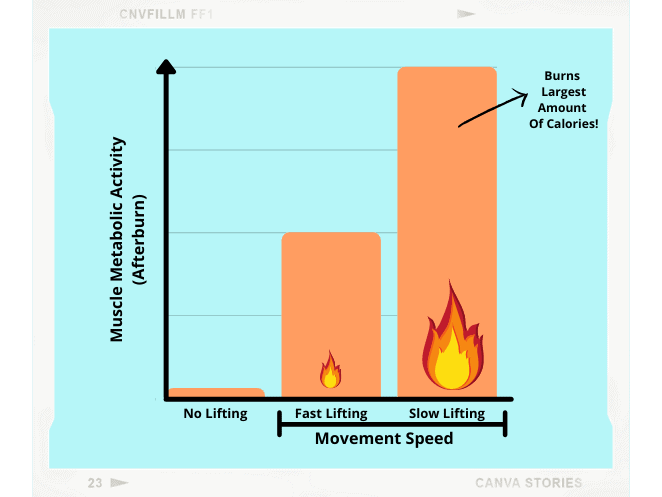
A study compared two groups of men- one group lifted weights with rapid movements, and the other group lifted with slow movement.(15)
The results of the study are impressive
Increasing the duration of time during which the muscle is under tension, increases the metabolic activity of the muscle post-workout.
In layman’s terms- slow and controlled lifting will increase the afterburn effect in your muscles! Increasing afterburn will increase calorie expenditure.
To get the same results from your workout, decrease the speed of the upward and downward movements in each lift.
This method of training is called Time Under Tension (TUT) training (more details can be found in our weight lifting for fat loss guide).
Many people, especially beginners, develop a bad habit of “dropping” weights on the downward motion. Or they use their body momentum to help lift a weight on the upward motion. Although these habits will make for an easier workout, you will NOT maximize the results of your workout.
When it comes to lifting weights to burn fat, lift slowly!
2) Fast Concentric & Slow Eccentric
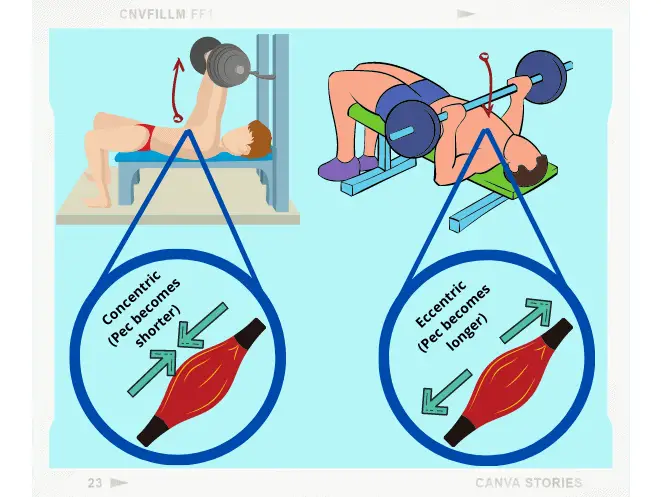
Now, lifting slowly and controlled for multiple reps may be difficult for beginner lifters.
So why not try a fast concentric & slow eccentric approach?
What do I mean by this?
A concentric muscle contraction is when a muscle becomes shorter as it produces force. In a bench press example, this would be the upward movement (the chest muscle contracts and shortens to lift the barbell).(17)
An eccentric movement is when a muscle becomes longer as it produces force. In a bench press example, this would be the downward movement (the chest muscle contracts and becomes longer to lower the barbell).
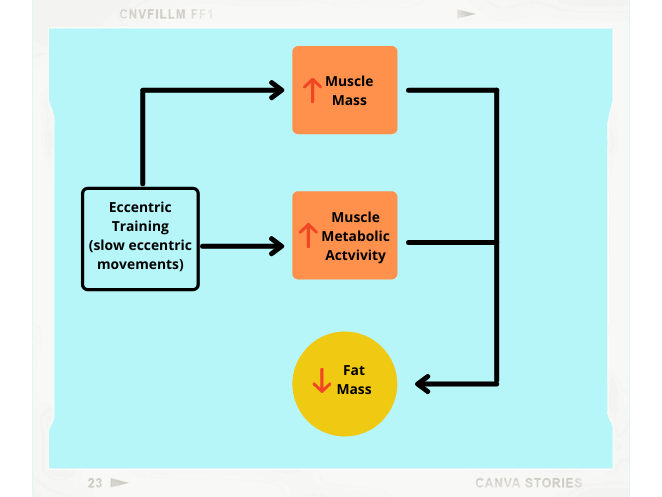
A separate study shows that eccentric training can increase muscle metabolic activity and lean mass, and decrease fat loss(16).
In layman’s terms- perform the eccentric movement in a slow and controlled manner to increase muscle activity and afterburn! This will burn calories!
In a bench press example, this would involve pushing the barbell up in a fast movement. Then lower the barbell slowly.
A fast concentric and slow eccentric approach is easier than TUT training. This makes it more realistic for beginner lifters, who may not be able to perform many reps in a slow and controlled movement.
Once you have mastered the fast concentric slow eccentric approach, move on to TUT training as described above.
3) Hold The Contraction
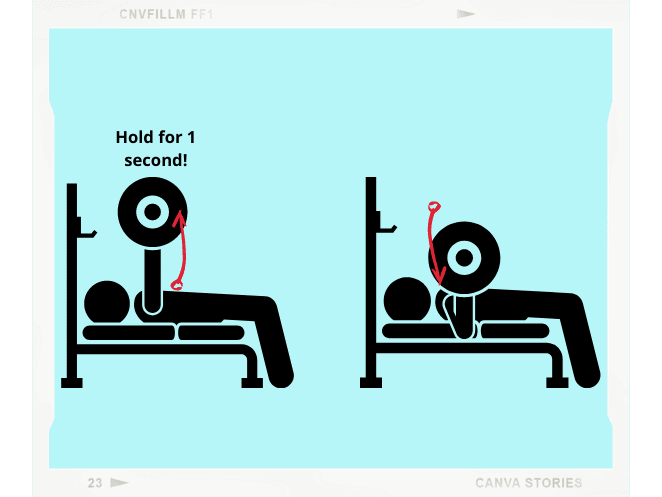
Holding a contraction simply means pausing for a second at the point of maximal muscle contraction.
This is the most beginner-friendly way to increase the time under tension of a muscle.
In a bench press example, push the bar up and hold it there for a second before lowering the bar again.
You will find this easier than the TUT and fast concentric/slow eccentric approach (as described in points 1) and 2)).
Try holding a contraction for a second to maximize muscle contraction time and calorie expenditure!(15)
4) Increase The Weight Not The Reps
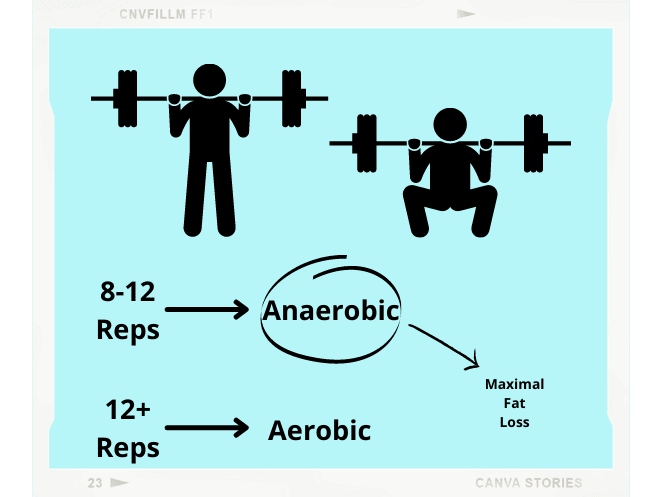
The perfect rep range for increasing muscle strength and decreasing fat composition is between 8-12 reps per set.(17)
Anything over this rep range, and you are entering aerobic exercise territory (i.e. cardiovascular training). Aerobic exercise may burn more calories during the workout, but anaerobic exercise (i.e. resistance training) will burn more total calories over a longer duration of time (through afterburn). (18)
Therefore you should always workout within the 8-12 rep range. If this becomes too easy, you can increase the weight load rather than the reps.
Don’t waste your valuable time performing 20+ reps of the same exercise!(19)
5) Shorten The Rest
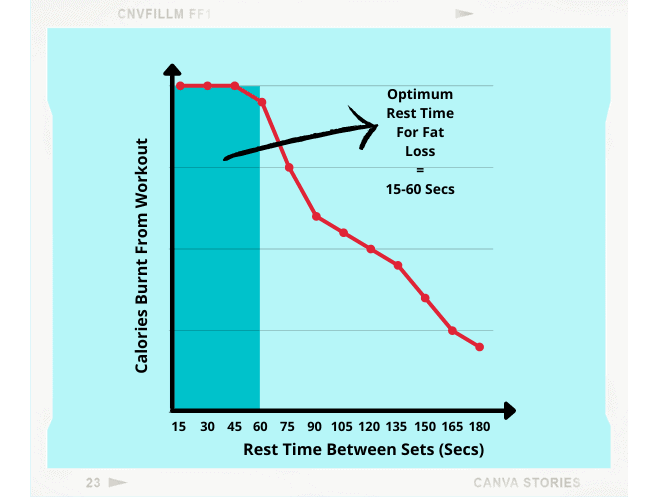
Do you go to the gym to burn fat or browse Instagram?
Sounds like a silly question. But many people spend more time on their phones than actually lifting weights!
Yes, rest periods are required between sets.
But don’t rest too long!
The ideal resting time between sets is 30-45 seconds. In fact, resting for 30 seconds will increase calorie expenditure by ~50%, compared to rest for 3 minutes.(20)
Resting for up to 1 minute is also ok. But do not be tempted to take any more time than that (certainly not a few minutes!).
When I “shred” in my bodybuilding program, I like to take a 1-minute rest between sets. This allows my muscles time to recover for the next set, whilst maximizing calorie expenditure.
When you decrease your rest time, you will find your heart rate increases for a longer duration of time. This is excellent for burning fat!
Conclusion
This wraps up today’s post!
I have explained the benefits of compound weight lifting to burn fat, how to perform the 5 core lifts, and 5 additional techniques to maximize fat burning.
But don’t forget- maximal fat loss can only be achieved when combined with an effective diet plan.
Will you be trying to burn fat with the 5 core lifts?
Feel free to send me a message if you have any questions! You can find my details on the “contact us” page.
You may also be interested in the downloadable Kalibre Blueprint PDF which details exactly how I gained 40lbs of lean muscle (it’s 100% free!). It details the exact exercises and nutrition (with printable worksheets) I used to go from skinny to ripped!
Thanks for reading guys!
Peace Out,
Kal
(Biochemistry BSc, Biomedical Sciences MSc, Ex-Skinny Guy)

